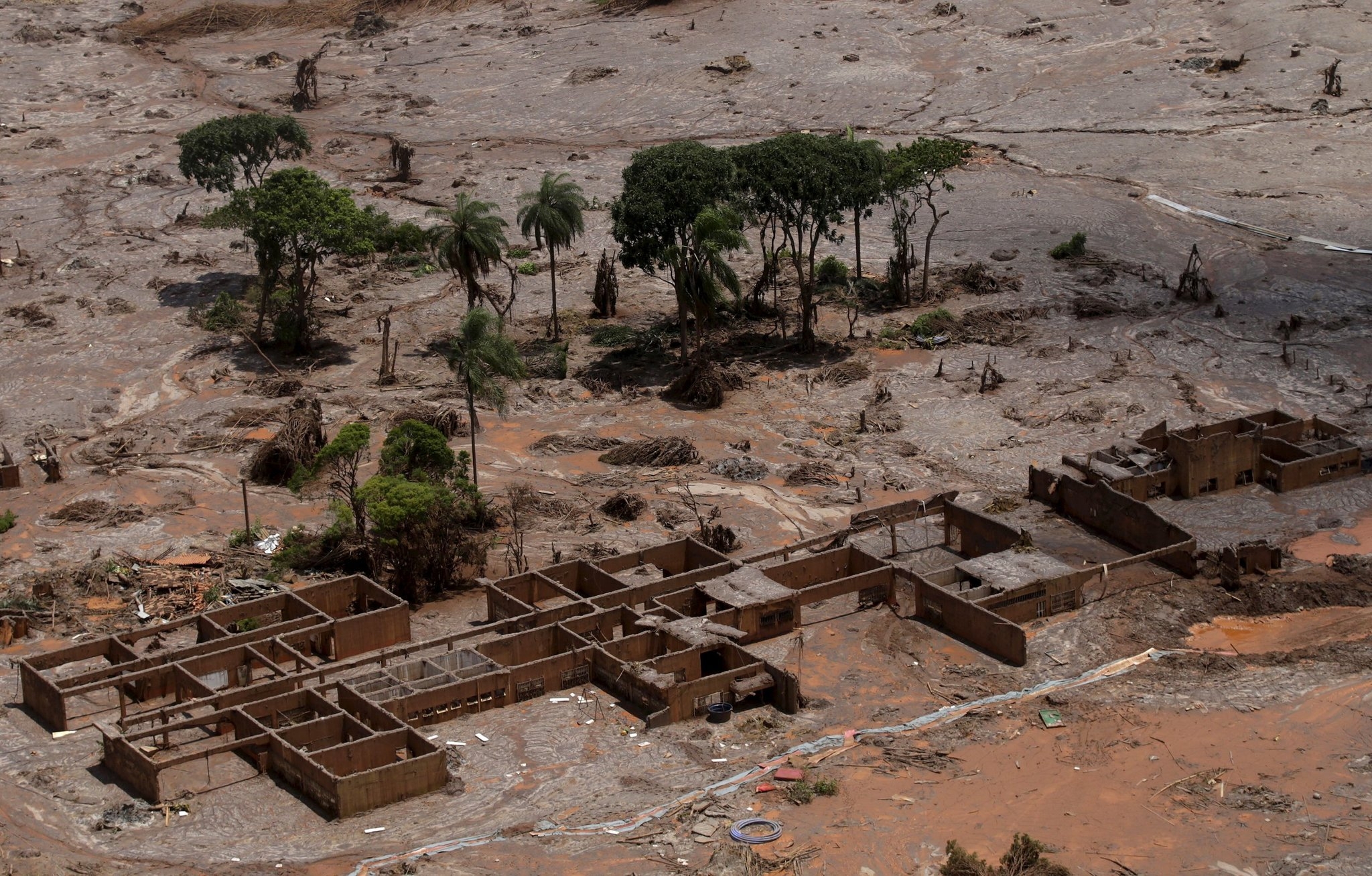
The school in Bento Rodrigues, Brazil, that was destroyed by mud from a collapsed dam. Credit Ricardo Moraes/Reuters
The New York Times
Dec. 17, 2015
by Vanessa Barbara
Contributing Op-Ed Writer
SÃO PAULO, Brazil — JUST after 4 p.m. on Nov. 5, the principal’s husband ran into the school in the village of Bento Rodrigues, in southeastern Brazil, yelling that the nearby dam had burst and everybody needed to get out of the schoolhouse. Teachers and employees herded about 50 children into buses and cars. Some followed on foot. Minutes later, as the caravan made its way uphill, they saw a 32-foot-tall wave of mud sweeping over their school.
The copper-colored sludge wiped out more than just the school. It destroyed the entire village. At least 16 people have died, including two children. Three people are still missing and 631 lost their homes.
The dam had been used to store water and mineral waste from a nearby iron-ore mine. It had no alarm system and no good emergency plan or designated evacuation routes. According to the villagers, nobody was warned about the breach. “If the dam had collapsed at night, everyone would have died,” said Duarte Júnior, the mayor of the city that includes Bento Rodrigues.
The dam was operated by Samarco, a joint venture between two multinational mining companies: Brazil’s Vale and the Anglo-Australian BHP Billiton. More than a month after the dam collapsed, it is unclear how long it will take for the ecosystem — and the economy — to recover. And two more dams in the area are at risk of collapsing.
After flooding the village, the wave of approximately 2.2 billion cubic feet of mud and mineral residue, enough to fill about 25,000 Olympic-size swimming pools, made its way to the Doce River. The river, which passes through 228 municipalities, is crucial to the region’s economic life. The mineral-waste sludge has devastated the area. Several companies had to suspend operations. Local fishermen are among the most severely affected. The water supply for Governador Valadares, a city of 300,000 people, had to be cut off for a week.
The companies involved insist that the muck poses no threat to human health. But two United Nations environmental experts declared that the mud contained “high levels of toxic heavy metals and other toxic chemicals.” A report from the Institute for Water Management, a government agency in the state of Minas Gerais, found that the water’s arsenic levels were 10 times above the legal limit. Other samples collected at different points along the river contained high levels of mercury, iron, aluminum and manganese.
According to Ibama, Brazil’s environmental protection agency, the Doce River is home to 80 fish species, of which 11 are endangered and 12 are found nowhere else in the world. “The instant death of the aquatic organisms is just one of the many impacts of the disaster,” said an Ibama report highlighting the damage to the ecosystem. Meanwhile, Samarco hired local fishermen to collect dead fish from the river’s banks and bury them.
The mud’s brown route across Brazil’s waterways is visible in NASA satellite images. Sixteen days after the dam broke, the tide reached the Atlantic Ocean, more than 400 miles downstream. It also spread into the Comboios Biological Reserve on the coast, a spawning area for loggerhead sea turtles and critically endangered leatherback sea turtles.
“The steps taken by the Brazilian government, Vale and BHP Billiton to prevent harm were clearly insufficient,” the United Nations environmental experts said in a statement, adding that it was unacceptable that it took three weeks for information about the water’s toxicity to surface. “The government and companies should be doing everything within their power to prevent further harm, including exposure to heavy metals and other toxic chemicals,” they said.
The exact cause of the breach has not yet been determined. Samarco’s chief executive officer suggested that a seismic tremor near the mine may have caused it, but public prosecutors suspect negligence by the company. Brazil’s press is criticizing the federal government in Brasília for failing to monitor the dam. The National Department of Mineral Production employed only four people in the whole state of Minas Gerais to inspect 735 dams.
Speaking at the climate conference in Paris on Nov. 30, President Dilma Rousseff said that “the irresponsible action of one company recently caused the biggest environmental disaster in the history of Brazil.” She claimed that the government was “severely punishing” those responsible for this tragedy.
Samarco has agreed to pay $262 million to fund initial cleanup efforts, and has granted monthly support of $204 to 115 families directly affected by the tragedy. The company has also been fined $66 million for polluting the Doce River and damaging freshwater supplies, with a 30 percent discount if the payment is made within 20 days. On Nov. 30, the government filed a civil suit demanding $5.2 billion over a decade.
But Brazilians have good reason to be skeptical. According to government statistics, environmental lawbreakers in Brazil paid less than 3 percent of fines levied against them over the past five years. Many people suspect that Vale and BHP will go unpunished and that safety regulations for the mining industry won’t be updated in light of the disaster.
If history is a guide, they may be right. When the dam broke last month, dozens of fishermen in the same area were already waiting for compensation — for the damage caused by the construction of the Aimorés hydroelectric power plant 10 years ago. The company responsible for the plant’s operation is called Aliança Energia. It’s another joint venture by Vale.
Vanessa Barbara is a columnist for the Brazilian newspaper O Estado de São Paulo, the editor of the literary website A Hortaliça and a contributing opinion writer.
A version of this op-ed appears in print on December 17, 2015, on page A39 of the New York edition with the headline: Brazil’s Toxic Sludge.

